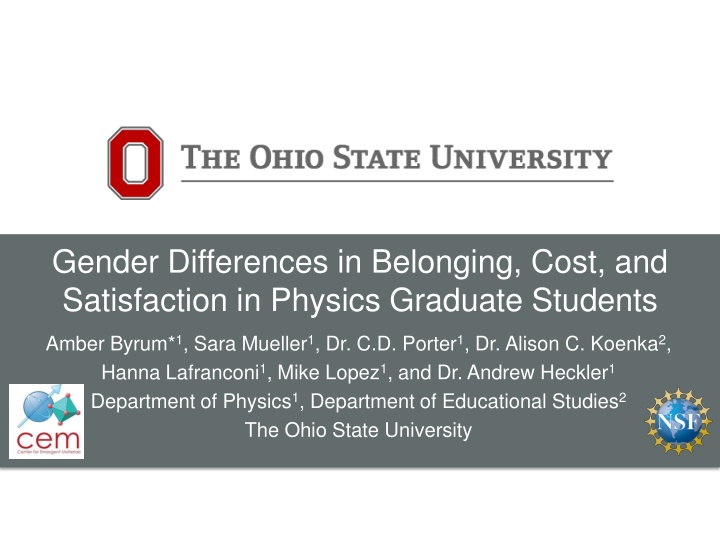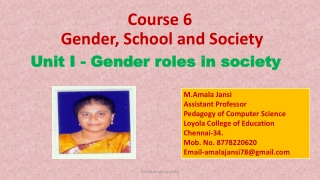Gender Differences in Belonging, Cost, and Satisfaction in Physics Graduate Students
This study explores gender disparities in belonging, cost, and satisfaction among physics graduate students to enhance diversity and student experience. Through survey data and measurement dimensions, the research aims to improve retention and success rates in the field.
Download Presentation

Please find below an Image/Link to download the presentation.
The content on the website is provided AS IS for your information and personal use only. It may not be sold, licensed, or shared on other websites without obtaining consent from the author.If you encounter any issues during the download, it is possible that the publisher has removed the file from their server.
You are allowed to download the files provided on this website for personal or commercial use, subject to the condition that they are used lawfully. All files are the property of their respective owners.
The content on the website is provided AS IS for your information and personal use only. It may not be sold, licensed, or shared on other websites without obtaining consent from the author.
E N D
Presentation Transcript
Gender Differences in Belonging, Cost, and Satisfaction in Physics Graduate Students Amber Byrum*1, Sara Mueller1, Dr. C.D. Porter1, Dr. Alison C. Koenka2, Hanna Lafranconi1, Mike Lopez1, and Dr. Andrew Heckler1 Department of Physics1, Department of Educational Studies2 The Ohio State University
Background Goal: Improve diversity, retention, and student experience in graduate physics Longitudinally examine: Cognitive and motivational factors How academic achievement, gender, and ethnicity relate to student success, retention, and student experience 2
Physics Graduate Populations A. First Year Core coursework Teaching At most, loose affiliation with research group 3
Physics Graduate Populations A. First Year Core coursework Teaching At most, loose affiliation with research group B. Pre-candidacy Less coursework Affiliated with research group Likely still teaching 4
Physics Graduate Populations A. First Year Core coursework Teaching At most, loose affiliation with research group B. Pre-candidacy Less coursework Affiliated with research group Likely still teaching C. Post-candidacy Primary function as research assistant 5
Design Design: Survey all graduate students every year ~200 total graduate students, divided into three populations Students complete population-dependent version of survey Likert scales used Incentives PopA (first year): first year course requirement, twice per year PopB (pre-candidacy): voluntary twice per year (part of annual review in future) PopC (post-candidacy): part of annual review, once per year 6
Measurement Dimensions Measured Scales Used Validated Value Belonging Identity Development Mindset Goal Orientation Anxiety/Stress Satisfaction Milestones Cost In Development Student Experience Teaching 7
Measurement Example Questions Belonging (22) I have found other graduate students in this graduate physics program with whom I relate. Satisfaction (15) In most ways my graduate experience in physics is close to my ideal. Cost (19) I have to sacrifice too much to be in this physics graduate program. 8
Satisfaction, PopB Average Satisfaction and Gender Identity 45 40 35 Percentage 30 25 20 15 10 5 0 -3 -2 -1 0 F 1 2 3 M Male (N=14) Female (N=7) Low satisfaction High satisfaction 0.82 0.27 -0.36 0.31 Mean SE Mann-Whitney p-value 0.02 9
Cost, PopB Average Cost and Gender Identity 45 40 35 Percentage 30 25 20 15 10 5 0 -3 -2 -1 0 F 1 2 3 M Male (N=14) Female (N=7) Low cost High cost -0.31 0.33 0.93 0.51 Mean SE Mann-Whitney p-value 0.04 10
Belonging, PopB Average Sense of Belonging and Gender Identity 70 60 50 Percentage 40 30 20 10 0 -3 -2 -1 0 F 1 2 3 M Male (N=14) Female (N=7) Low sense of belonging High sense of belonging 1.38 0.18 0.54 0.32 Mean SE Mann-Whitney p-value 0.05 11
Summary Summary: In initial stages of longitudinal study We have found in preliminary data some problematic differences in men and women s physics experiences On average, males report higher satisfaction than females Women report higher cost than men Most men report a high average belonging, whereas most women average a neutral belonging 12
Future Work Plans for future: More years, more N Examine underrepresented minority data Track changes in individual student responses Compare response patterns between populations Analyze how population response patterns change over time 13
Bibliography [1] Perez, Cromley, & Kaplan. (2014). Journal of Educational Psychology, 106: 315 329. doi:10.1037/a0034027 [2] https://www.nsf.gov/statistics/srvydoctorates/ [3] Hyater-Adams, Hinko, & Finkelstein. 2015 PERC Proceedings, edited by Churukian, Jones, and Ding; Peer-reviewed, doi:10.1119/perc.2015.pr.033 [4] Dabney & Tai. (2013) Phys. Rev. ST Phys. Educ. Res. 9, 010115, doi:10.1103/PhysRevSTPER.9.010115 [5]Gonsalves, Danielsson,& Pettersson. (2016) Phys. Rev. Phys. Educ. Res. 12, 020120. doi:10.1103/PhysRevPhysEducRes.12.020120 [6] Goodenow, C. (1993), Psychol. Schs., 30 : 79 90. doi:10.1002/1520-6807(199301)30:1<79::AID- PITS2310300113>3.0.CO;2-X [7] Kaplan, A., & Midgley, C. (1997). Contemporary Educational Psychology, 22: 415-435. doi:10.1006/ceps.1997.0943 [8]Blackwell, L. S., Trzesniewski, K. H. and Dweck, C. S. (2007). Child Development, 78 : 246 263. doi:10.1111/j.1467-8624.2007.00995.x [9]Midgley, Kaplan, Middleton, Urdan, Maehr, Hicks, Anderman, & Roeser. (1998). Contemporary Educational Psychology, 23: 113 131. doi:10.1006/ceps.1998.0965 [10] Battle & Wigfield. (2003). Journal of Vocational Behavior, 62: 56-75 doi:10.1016/S0001-8791(02)00037-4 [11] Vaez, PhD, M., & Laflamme, L. (2008). Social Behavior and Personality: An international journal, 36: 183-196. doi: 10.2224/sbp.2008.36.2.183 [12] Eccles & Wigfield. (2000). Contemporary Educational Psychology, 25: 68 81 doi:10.1006/ceps.1999.1015 [13]Larsen, RJ, Diener, E and Emmons, RA. (1985). Social Indicators Research, 17:1 18.doi: 0303-8300/85.10 [14]Lock, R., Hazari, Z., & Potvin, G. (2012). 2012 PERC Proceedings, Philadelphia, PA. doi:10.1063/1.4789702 14
Acknowledgements Funding for this research was provided by the Center for Emergent Materials: an NSF MRSEC under award number DMR-1420451 Want to hear more about physics retention? PERC Contributed posters: Byrum A11, Mueller A45, Lafranconi B32 15























